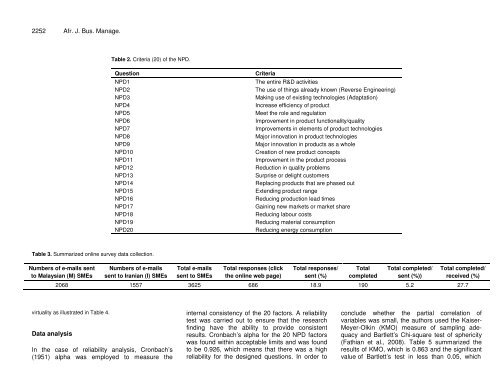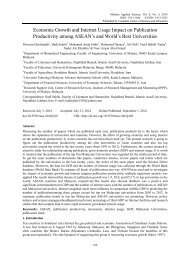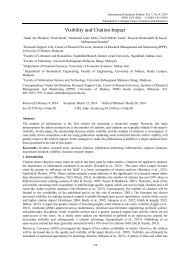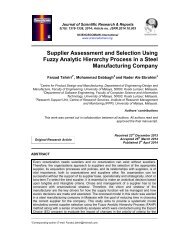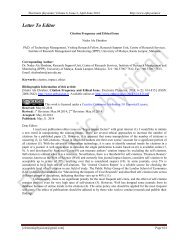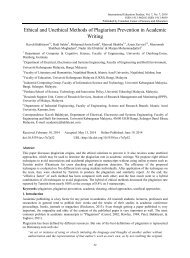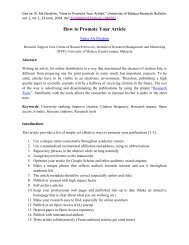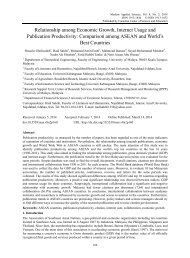Critical factors for new product developments in SMEs virtual team
Create successful ePaper yourself
Turn your PDF publications into a flip-book with our unique Google optimized e-Paper software.
2252 Afr. J. Bus. Manage.<br />
Table 2. Criteria (20) of the NPD.<br />
Question<br />
NPD1<br />
NPD2<br />
NPD3<br />
NPD4<br />
NPD5<br />
NPD6<br />
NPD7<br />
NPD8<br />
NPD9<br />
NPD10<br />
NPD11<br />
NPD12<br />
NPD13<br />
NPD14<br />
NPD15<br />
NPD16<br />
NPD17<br />
NPD18<br />
NPD19<br />
NPD20<br />
Criteria<br />
The entire R&D activities<br />
The use of th<strong>in</strong>gs already known (Reverse Eng<strong>in</strong>eer<strong>in</strong>g)<br />
Mak<strong>in</strong>g use of exist<strong>in</strong>g technologies (Adaptation)<br />
Increase efficiency of <strong>product</strong><br />
Meet the role and regulation<br />
Improvement <strong>in</strong> <strong>product</strong> functionality/quality<br />
Improvements <strong>in</strong> elements of <strong>product</strong> technologies<br />
Major <strong>in</strong>novation <strong>in</strong> <strong>product</strong> technologies<br />
Major <strong>in</strong>novation <strong>in</strong> <strong>product</strong>s as a whole<br />
Creation of <strong>new</strong> <strong>product</strong> concepts<br />
Improvement <strong>in</strong> the <strong>product</strong> process<br />
Reduction <strong>in</strong> quality problems<br />
Surprise or delight customers<br />
Replac<strong>in</strong>g <strong>product</strong>s that are phased out<br />
Extend<strong>in</strong>g <strong>product</strong> range<br />
Reduc<strong>in</strong>g <strong>product</strong>ion lead times<br />
Ga<strong>in</strong><strong>in</strong>g <strong>new</strong> markets or market share<br />
Reduc<strong>in</strong>g labour costs<br />
Reduc<strong>in</strong>g material consumption<br />
Reduc<strong>in</strong>g energy consumption<br />
Table 3. Summarized onl<strong>in</strong>e survey data collection.<br />
Numbers of e-mails sent<br />
to Malaysian (M) <strong>SMEs</strong><br />
Numbers of e-mails<br />
sent to Iranian (I) <strong>SMEs</strong><br />
Total e-mails<br />
sent to <strong>SMEs</strong><br />
Total responses (click<br />
the onl<strong>in</strong>e web page)<br />
Total responses/<br />
sent (%)<br />
Total<br />
completed<br />
Total completed/<br />
sent (%))<br />
Total completed/<br />
received (%)<br />
2068 1557 3625 686 18.9 190 5.2 27.7<br />
<strong>virtual</strong>ity as illustrated <strong>in</strong> Table 4.<br />
Data analysis<br />
In the case of reliability analysis, Cronbach’s<br />
(1951) alpha was employed to measure the<br />
<strong>in</strong>ternal consistency of the 20 <strong>factors</strong>. A reliability<br />
test was carried out to ensure that the research<br />
f<strong>in</strong>d<strong>in</strong>g have the ability to provide consistent<br />
results. Cronbach’s alpha <strong>for</strong> the 20 NPD <strong>factors</strong><br />
was found with<strong>in</strong> acceptable limits and was found<br />
to be 0.926, which means that there was a high<br />
reliability <strong>for</strong> the designed questions. In order to<br />
conclude whether the partial correlation of<br />
variables was small, the authors used the Kaiser-<br />
Meyer-Olk<strong>in</strong> (KMO) measure of sampl<strong>in</strong>g adequacy<br />
and Bartlett’s Chi-square test of sphericity<br />
(Fathian et al., 2008). Table 5 summarized the<br />
results of KMO, which is 0.863 and the significant<br />
value of Bartlett’s test <strong>in</strong> less than 0.05, which


